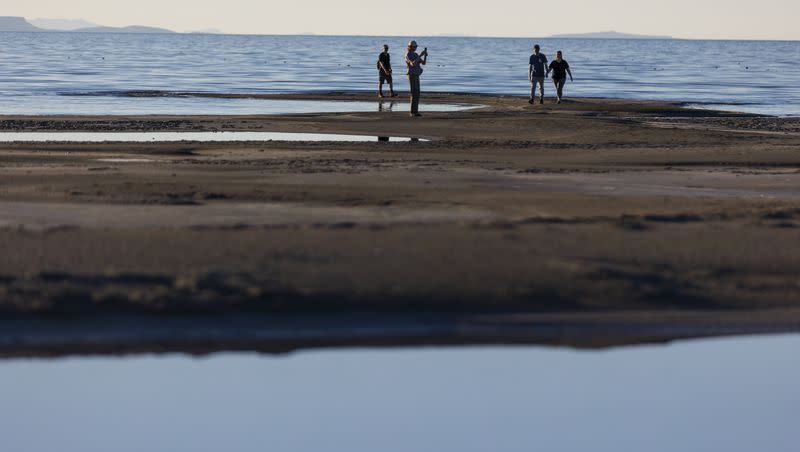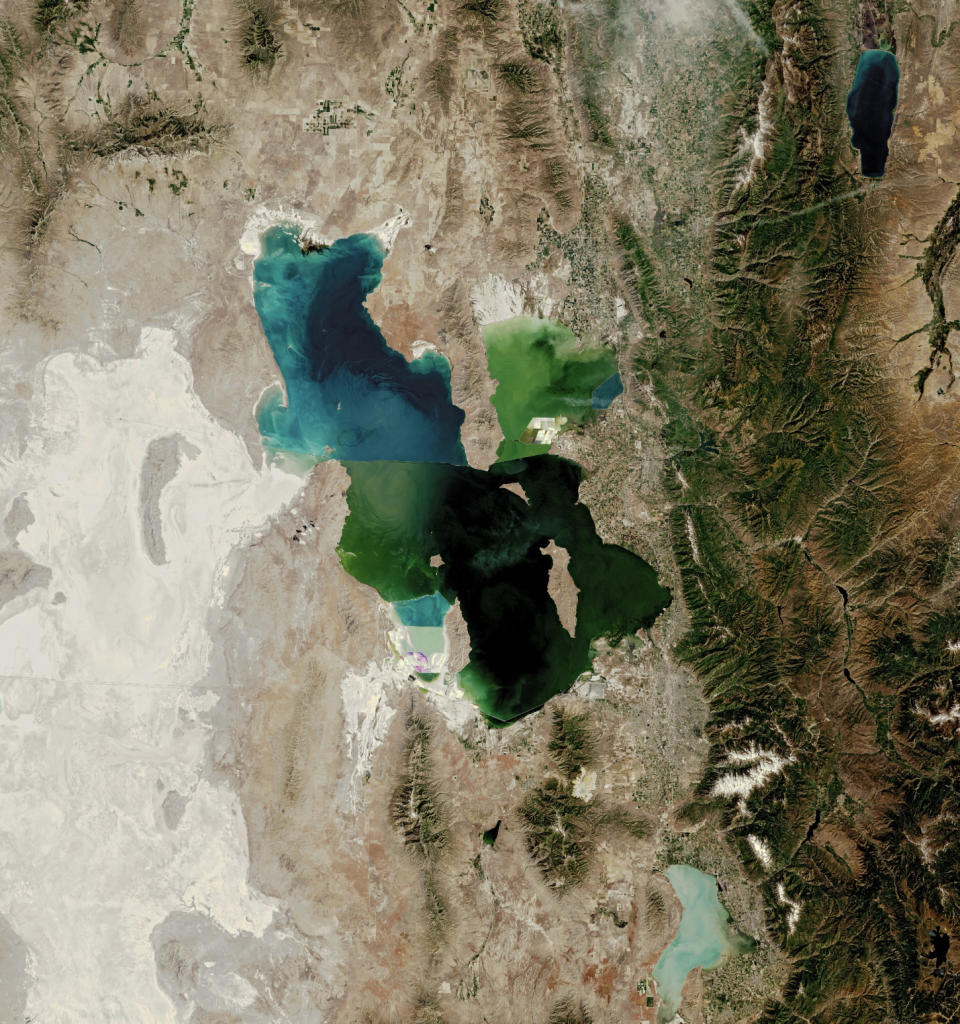What early church leaders said about the Great Salt Lake

- Oops!Something went wrong.Please try again later.
- Oops!Something went wrong.Please try again later.
This article was first published in the ChurchBeat newsletter. Sign up to receive the newsletter in your inbox each Wednesday night.
This story is about the Great Salt Lake and the Church of Jesus Christ, but we’re going to begin by talking about the Dallas Cowboys, if you’ll allow some latitude. You’ll see the relevance shortly, your honor.
The Cowboys, you see, play in a massive stadium. Let’s put it this way. Last fall, the Cowboys led the NFL in attendance. By a lot. They averaged nearly 93,500 fans per game. The second-place team, the New York Jets, if you can believe it, drew 78,000 per game.
Related
Opinion: The church’s historic water donation for saving the Great Salt Lake is the ‘Utah Way’
Church makes largest-ever donation of water shares to benefit Great Salt Lake
Now, back to the lake and the church.
The church has agreed to reroute and donate 20,000 acre-feet of water it had used for agriculture to the help sustain the Great Salt Lake, which is in crisis. In fact, a recent BYU study said the massive lake, which is nearly 75 miles long, could disappear in five years.
That would be a calamity. Bad for wildlife, bad for snowfall — lake-effect snow provides a great deal of Utah’s water and the setting for its ski industry — and bad for human beings. A dry lakebed would create more dust in the wind along the densely populated western slopes of the Wasatch Mountains.
The lakebed’s dust is laced with toxic arsenic.
The Cowboys factor in as a visual image for how much water the church donated. As you might imagine, to fit 93,500 fans into AT&T Stadium means it is enormous.
The church’s annual donation of water, which will be provided in perpetuity, is equal to flooding AT&T Stadium to the top of its retractable roof more than six times.
The donation ensures water will continue to flow into the Farmington Bay part of the lake while the Utah Legislature and others scramble for more water to save the lake.
The NASA Earth Observatory published a story last year called “The Great Shrinking Lake,” illustrated by satellite images worth 1,000 words.


The earliest of Latter-day Saint leaders talked about plans in the American West within a year of the church’s founding in 1830, according to historian Ron Esplin. By 1839, they believed they needed a secure, isolated location, and church founder Joseph Smith said they “would leave ... and go to the mountains,” according to Brigham Young. By 1840, Joseph Smith was talking about the Rocky Mountains, Esplin wrote.
Latter-day Saint leaders devoured published reports of John C. Frémont’s two expeditions to the Rockies, the second of which emphasized the Great Salt Lake region and described it as the Great Basin.
“No doubt thinking of Mormon hopes for a place of refuge,” Esplin wrote, “... John Taylor noted that a ‘basin which may hold such a kingdom as France, and which has for its rim a circle of mountains whose summits penetrate the regions of eternal snows is certainly a new and grand subject to be revealed.’”
After “our exit to the Mountains,” Brigham Young would say, the Great Salt Lake Valley was “a place ‘sought out.’”
In July 1847, four days after the Latter-day Saints reached what they called the Great Salt Lake Valley, President Young and pioneers were floating in the briny lake, reported historian John L. Clark.
“We took our dinner at the freshwater pool and then rode six miles to a large rock on the shore of the Salt Lake which we named Blackrock, where we all halted and bathed in the salt water,” future church president Wilford Woodruff wrote. “No person could sink in it but would roll and float on the surface like a dry log. We concluded that the Salt Lake was one of the wonders of the world.”
After arriving in the valley, church leaders postmarked their first general epistle to the Saints from Great Salt Lake City, historian Richard H. Jackson wrote. By 1866, they dropped Great from the name.
The lake is a wonder. It holds about 4.5 billion tons of salt. Its remarkable natural features made it a major peculiarity for decades, but resorts built on its shores suffered because of the lake’s ever-changing levels.
Other, more modern curiosities have overtaken those of the lake. Today, few people talk about floating in it. The historian Jackson noted in 1988 that unless it floods — which it has, requiring the need to pump water out of the lake — the Great Salt Lake got little attention anymore.
Thirty-five years later, that’s no longer true. Irrigation and drought threaten to kill the lake, portending an ecological and economic disaster.
The lake now stands at 4,189.42 feet above sea level, down from the historic high of 4,211.6 feet set in 1986.
The current volume as winter closes is just slightly above the record low set in November, when the water fell to 4,188.2 feet. The lake usually reaches its annual peak in May with the spring runoff, then wanes again through summer and into early fall.
You can still swim in the Great Salt Lake. Read more here.
My recent stories
Church makes largest-ever donation of water shares to benefit Great Salt Lake (March 15)
President Russell M. Nelson will receive Gandhi-King-Mandela Peace Prize (March 14)
About the church
Two stories from Elder Neil L. Andersen’s nine-day ministry tour in Brazil:
How Elder Andersen’s “small life” became enlarged through serving and repeatedly ministering in Brazil.
Elder Andersen meets with Brazil’s first lady and makes donation to feed children and gives invitation for a temple tour.
A young missionary serving in his native DR Congo died from an undetermined illness.
A new Joseph Smith Papers podcast focuses on revelations during the time the church was headquartered in Kirtland, Ohio.
The Moses Lake Washington Temple will be dedicated in September — the third dedication that day.
The announced the exact location of the Cody Wyoming Temple.
More than 700 Indigenous members of the church from dozens of communities attended a two-day “Gathering of Tribes” in Arizona.
What I’m reading
Is BYU the most politically balanced university in America?
Religious people long have been disillusioned with the way Hollywood treats religion, writes our Hanna Seariac. “Simply put, there are better stories to tell about religion and religious people than stories that seek to portray a shift away from religion as inevitable.” She explores how Hollywood is selling nihilism and a single narrative about religion and meaning.
Former NBA player Mark Madsen trying to do a different kind of dance as the head coach of the Utah Valley University men’s basketball team.
A new BYU study shows one way adolescents can develop a healthy identity and why it matters.
And, Elizabeth Smart was rescued from her kidnappers 20 years ago.

